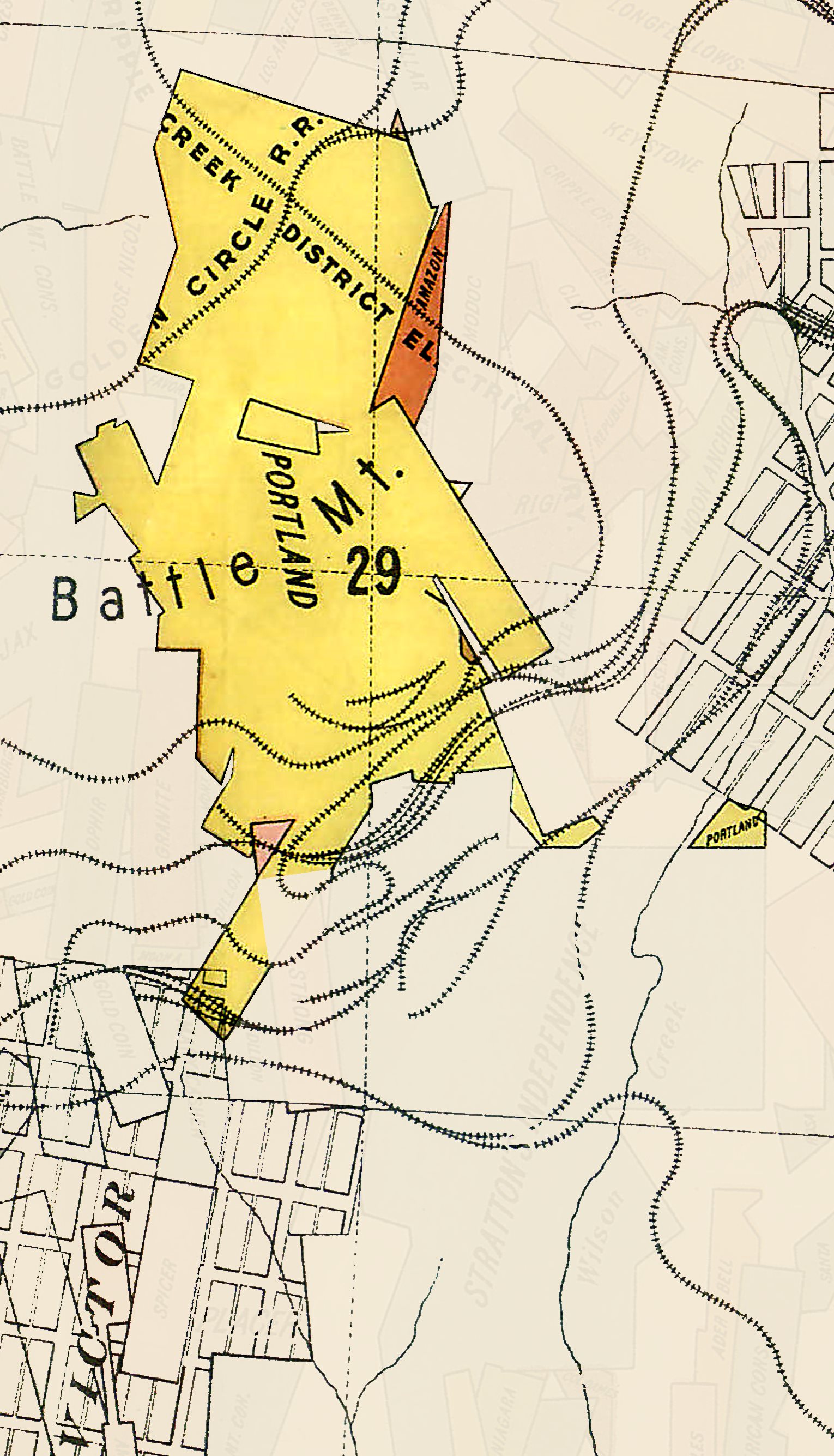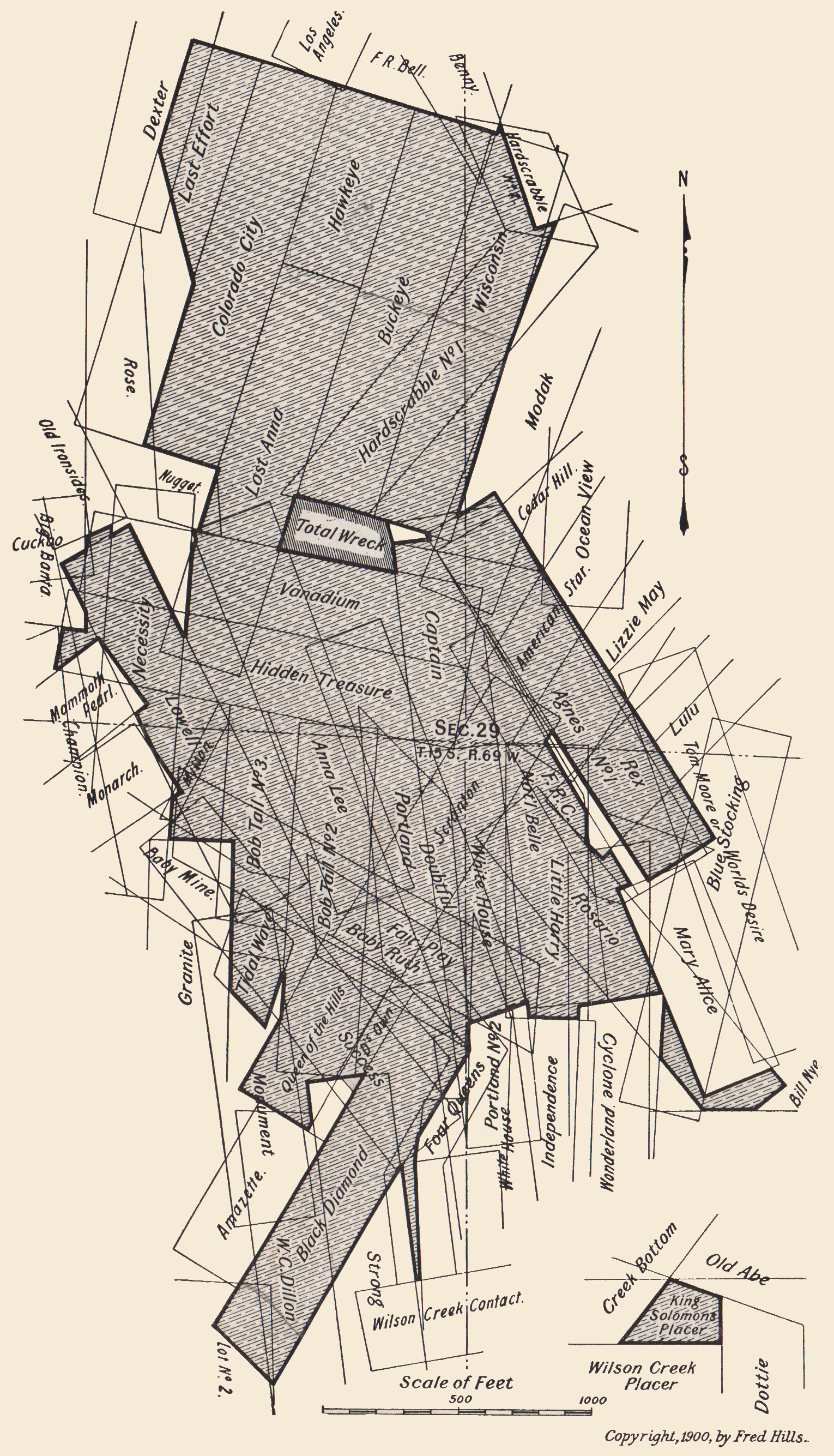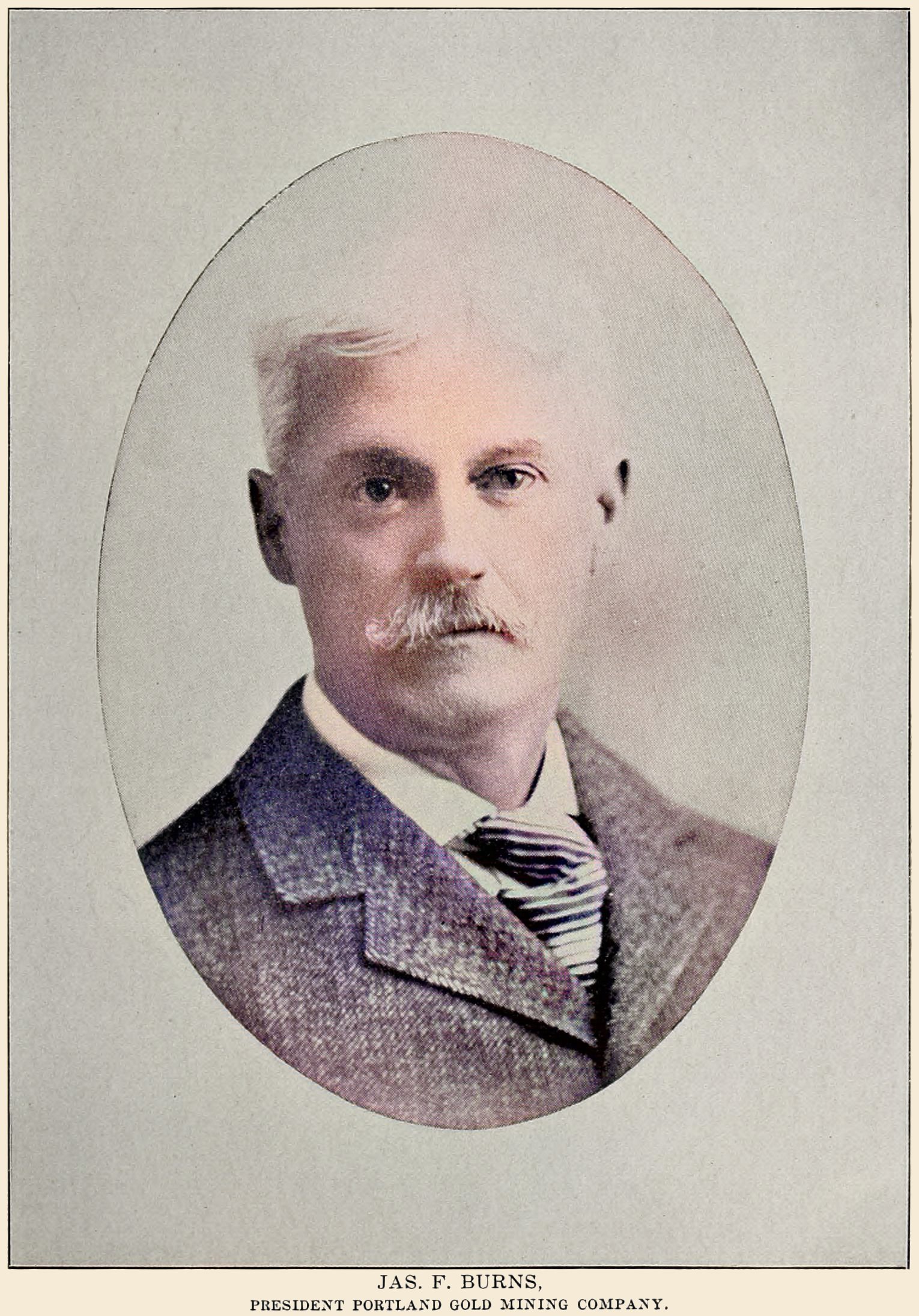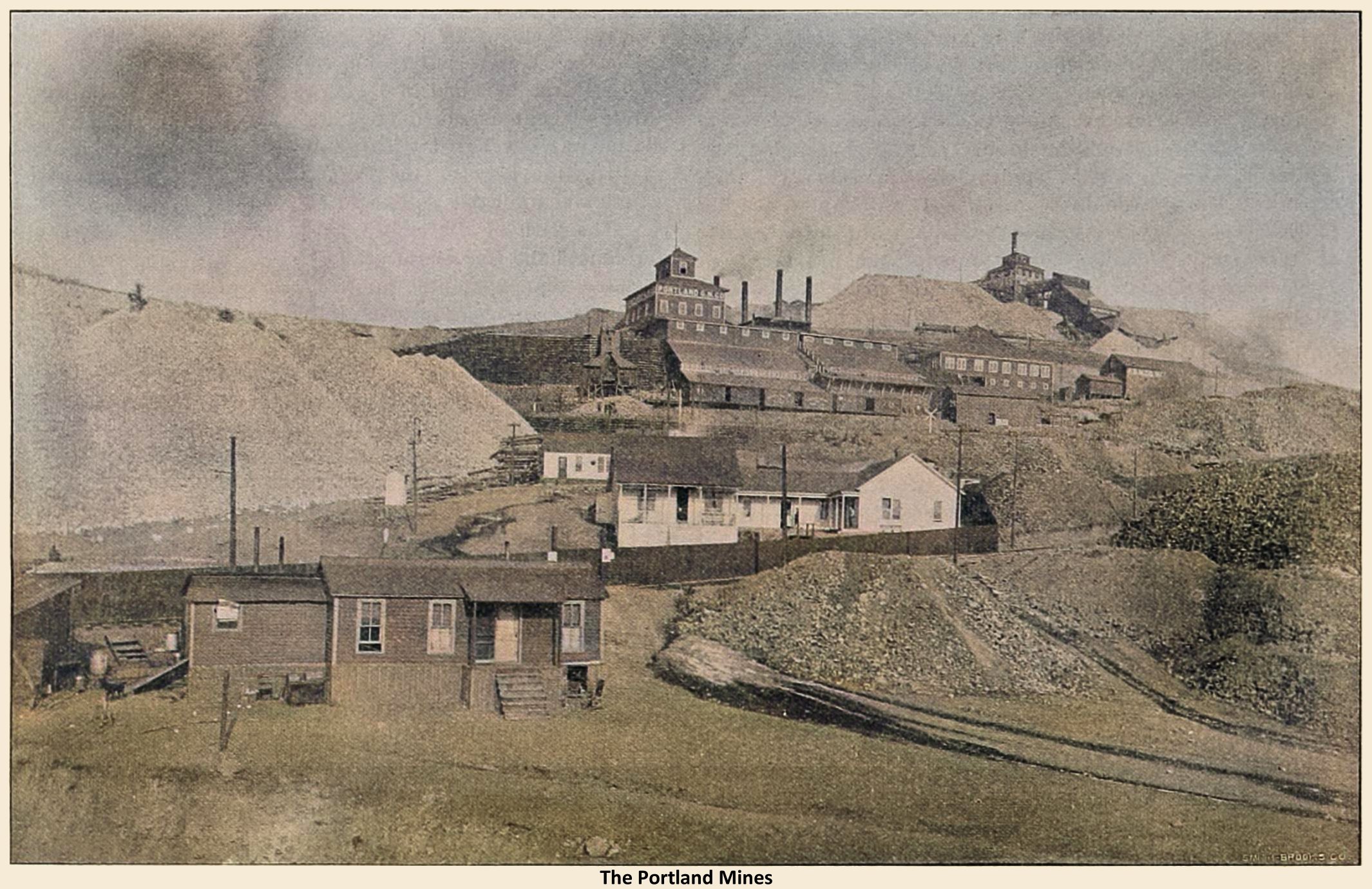-> My Collection, Also on
-> the Internet Archive Site; Link to article.
New Year Edition 1903
(pages 81-82 & unpaginated page)
I added 2 maps from Hills 1900 Manual.
When the first stake was set, in January, 1892, claiming the Portland claim, little did the locator think the day would come when all the surrounding property would be owned, and the claim would be part of the most gigantic mining corporation in the entire state of Colorado.
The original location of the Portland Company, which was the Portland claim, consisted of one-tenth of an acre and the Bobtail No. 2, the total of the two containing less than three acres of ground.
Besides that, the owners acquired a lease on the Queen of the Hills and a bond and lease on the Hidden Treasure. The two latter acquisitions were in litigation.
After the location of the property, James F. Burns, John Harnan and James Doyle commenced operations on it, and in January of 1893 they made their first shipment of ore, consisting of thirty-two sacks, to Pueblo.
The ore was settled for at $640.00 to the ton in gold. The first ore was obtained while sinking the shaft from the surface to the depth of thirty-five feet.
Just a year after they made the first shipment, the owners gave an option on the property to T. J. Condon and Walter F. Crosby, who, a month later, in February, 1894, organized the Portland Company.
It was capitalized for $3,000,000.00, divided into 3,000,000 shares, of a par value of $1.00 each. The purchase price of the property was $200,000.00. The sum of $15,000.00 was made as the first payment, which meant $5,000.00 to each of the three owners.
When the second payment became due, they failed to meet it.
Then Messrs. Burns, Harnan and Doyle took charge of the company. A special meeting was held, at which the resignations of the old officers and board of directors were accepted, and new officers elected, as follows:
James F. Burns, president and treasurer
W. S. Stratton, vice president
Frank G. Peck, secretary
The company owned less than three acres, and had litigation to contend with, and little did they think that in a few years the company would own every foot of property adjoining them, giving them a total of close to 200 acres of the richest territory in the entire district: and little did they think that in acquiring property they would pay out a sum close to $2,000,000, besides expending large sums in litigation, all of which would be taken out of the ground during the course of development.
The first serious litigation encountered was an injunction suit filed by the owners of the Scranton and Doubtful claim, in which the apex rights were claimed by the former people.
The Doubtful claim was owned by Messrs. Lennox, Giddings and Colburn, who demonstrated the fact that they had the apex of the ore being worked by the Portland people, for during the course of proving their rights they followed the ore right into the Portland workings.
The labor troubles came about that time, and the law suit was compromised in August, by the Portland Company paying Messrs. Lennox, Giddings and Colburn the sum of $265,000.00, and receiving a deed for the Doubtful, Annie Lee, White House, Captain and National Bill Belle claims.
So far as the Scranton litigation was concerned, the property was practically the keynote of the entire situation. and was bought by the Portland Company.
The next property acquired was the Queen of the Hills, Baby Ruth, Hidden Treasure and Vanadium. That parcel of ground was purchased from B. F. and W. S. Montgomery. W. S. Pigg and Charles Cover.
With clear titles to these properties all litigation was practically settled, outside of the Bobtails, which was bought later on. The Portland Company now owned about 100 acres of territory.
In November of 1894, the King Solomon placer was acquired.
In July, 1895, some litigation was started with W. S. Stratton over the Black Diamond, Lowell, Fairplay, Success, Casco group? (Cyclone, Little Harry, Rosario), Lost Anna and Terrible group? (Hardscrabble No. 1 and No. 2). The matter was settled satisfactorily to all.
Then the Devil's Own and Tidal Wave claims were purchased.
In March or April of 1895, the Four Queens claim, containing about as much territory as the original Portland claim, was purchased. This latter property was the cause of litigation between the Portland and Strong companies, which was amicably settled April 15, 1901.
The 24th of December, 1898, the Portland Company purchased the Rex claim.
Less than a month following, on the 6th of January, 1899, the Morse group (Buckeye, Colorado City, Hawkeye, Last Effort and Wisconsin lodes), containing about fifty acres of territory, in a compact group, was acquired.
That was followed by the purchase of a fifty-two one-hundredths interest of the Total Wreck, owned by the late Sam Strong.
This was the last purchase made by the Portland Company, and gave them about 200 acres of Battle mountain, which has fast proven to be the treasure vaults of the district.
By the dates it will be seen that in less than five years the company that started with less than three acres, owned close to 200 acres of very rich territory. Every penny expended was realized from the sale of ore taken out of the ground. Besides the money expended for property, there were fortunes spent in litigation.
The Portland Company has the distinction of never having sold one share of treasury stock for the purpose of acquiring money for development purposes. From the first time that ore was encountered they commenced to mine, and as development proceeded, more ore was opened, and the prospects of the mine looked better.
The Portland mine today is the best developed mine in the state, and above the 1,100-foot level there are twenty-five miles of workings, which have exposed fifty ore-bearing veins. At the present time only twenty of the veins are being worked. Development is being pushed steadily in the other veins, and ore is being blocked out in an astonishing manner.
The equipment of the company is the finest in the state. Three shafts furnish the exit for the great tonnage of ore. The company has torn out the old battery of boilers that have been in use since 1896, and is installing the latest type of boilers.
Big improvements are being made at the No. 2 shaft. There tramways and belt conveyors are being installed for the more economical handling of the ore. The company will dispense with the use of cages to hoist the ore through the shaft.
A "skip" will be installed, such as is used so extensively in the Lake Superior region and Montana. That improvement alone will make a very considerable saving, and the Portland mine will be the first mine so equipped in the state.
The Portland Company, to date, has paid the enormous sum of $4,297,080.00 in dividends to the stockholders, which will be an insignificant amount compared to the figures that will be shown when the mine is worked, years and years hence.
From the present standpoint of development, with the ore in sight above the 1,100-foot level, a production of 10,000 tons of ore a month can be maintained for the next ten years. Such an enormous tonnage can be made simply from the ore in sight, and without any further development.
That tonnage of ore means that there is in sight, above the 1,100-foot level, the enormous sum of $36,000,000.00.
The actual management and development of the great bonanza has always been in the charge of James F. Burns, and to him is due the credit for making the company what it is today.
To date, the company has hoisted 400,000 tons of ore, that has yielded in gold the sum of $17,000,000.00. It has always been the rule of the management to make such improvements that would lessen the cost of mining and better the condition of the property.
The past is a sufficient guarantee for the future. In ten years there has been produced $17,000,000.00 worth of gold-bearing ore, and there remains in the mine, blocked out, $36,000,000.00.
What will be opened yet in undeveloped ground, above the 1,100-foot level and below, is conjectural; but it is a safe assertion to make, that the figures now at hand will be insignificant when the shaft has attained a depth of 2,000 feet.



